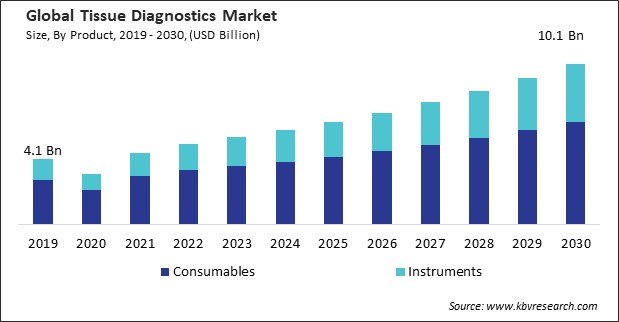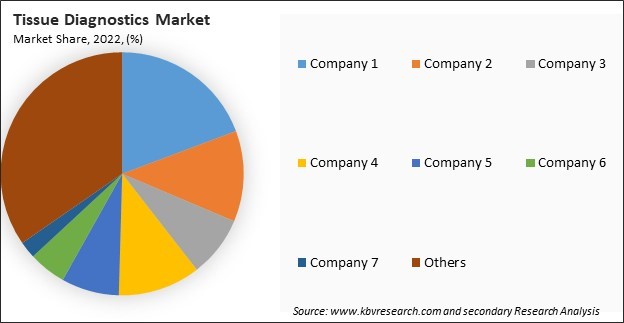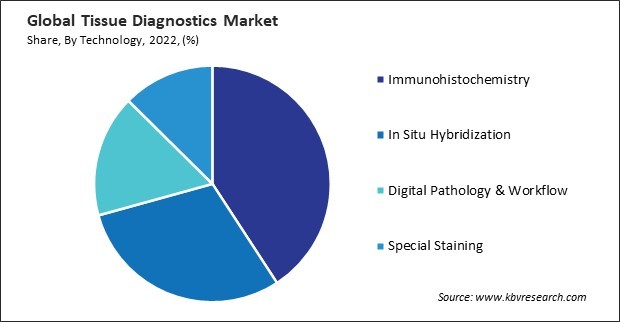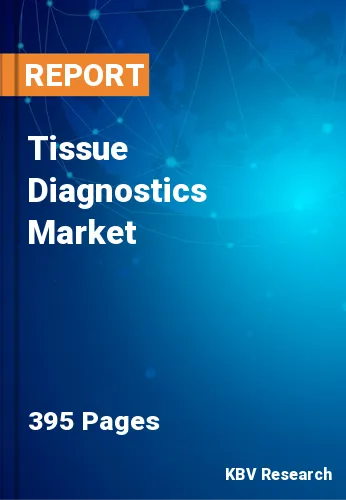“Global Tissue Diagnostics Market to reach a market value of USD 10.1 Billion by 2030 growing at a CAGR of 9.1%”
The Global Tissue Diagnostics Market size is expected to reach $10.1 billion by 2030, rising at a market growth of 9.1% CAGR during the forecast period.
Prostate cancer is one of the most prevalent cancers in men, particularly in older age groups. Therefore, the Prostate cancer segment captured $544.4 million revenue in the market in 2022. The aging population, along with increased awareness and screening efforts, has led to the identification of more cases, driving the demand for prostate cancer diagnostics. Hence, these factors will lead to increased growth in the segment.

Tissue diagnostics, including techniques such as histopathology and cytology, are essential for the early detection and accurate diagnosis of cancer. Early diagnosis is critical for timely and effective treatment, improving patient outcomes. It helps identify specific biomarkers associated with different types of cancers. Biomarkers are molecular or cellular indicators that can signal the presence of cancer, its subtype, and its potential response to certain treatments. Tissue analysis allows for the identification and characterization of these biomarkers. Additionally, Immunohistochemistry involves the use of antibodies to detect specific proteins in tissue samples. When these antibodies bind to their target proteins, they produce a visible color change, allowing for identifying and localizing specific antigens within the tissue. In cancer diagnostics, IHC is frequently employed to identify particular biomarkers associated with distinct forms of cancer. It provides valuable information about the expression of proteins in cancer cells, aiding in the classification of tumors and guiding treatment decisions. Thus, these factors will help in the expansion of the market.
Further, laboratories and diagnostic centers experienced a surge in demand for COVID-19 testing, leading to a shift in priorities. Resources, including personnel and equipment, were redirected towards performing and processing COVID-19 tests. To mitigate disruptions, there was an increased adoption of telemedicine and digital pathology solutions. Remote consultations, virtual tumor boards, and digital slide sharing became more prevalent, allowing pathologists to analyze tissue samples from various locations. Therefore, the COVID-19 pandemic moderately impacted the market.
However, smaller healthcare facilities and laboratories often operate with constrained budgets, making it challenging to allocate significant funds to purchase expensive tissue diagnostics equipment upfront. The capital expenditure required for acquiring histology and cytology instruments can strain the financial resources of these organizations. In resource-limited settings, healthcare organizations may need to prioritize their spending on essential needs such as patient care, basic diagnostic equipment, and infrastructure. Smaller healthcare facilities may be cautious about investing in high-cost equipment without a clear understanding of the return on investment (ROI). Demonstrating the clinical and economic benefits of tissue diagnostics, including improved diagnostic accuracy and patient outcomes, becomes crucial in justifying the initial and ongoing costs. Thus, these factors can restrain the demand for tissue diagnostics in the coming years.

The leading players in the market are competing with diverse innovative offerings to remain competitive in the market. The above illustration shows the percentage of revenue shared by some of the leading companies in the market. The leading players of the market are adopting various strategies in order to cater demand coming from the different industries. The key developmental strategies in the market are Acquisitions, and Partnerships & Collaborations.
Based on product, the market is segmented into consumables and instruments. In 2022, the instruments segment garnered a significant revenue share in the market. Continuous technological progress has resulted in the creation of increasingly sophisticated and high-performing instruments utilized in tissue diagnostics. These instruments often incorporate innovative features such as automation, precision, and enhanced imaging capabilities, improving diagnostic processes' overall efficiency and accuracy. Thus, these factors will fuel the growth in the segment.
On the basis of technology, the market is divided into immunohistochemistry, in situ hybridization, digital pathology & workflows, and special staining. The immunohistochemistry segment recorded the maximum revenue share in 2022. Immunohistochemistry plays a pivotal role in cancer diagnostics. It allows pathologists to identify and characterize specific proteins associated with different types of cancer. The growing prevalence of cancer cases worldwide has led to an increased demand for IHC for both diagnosis and prognosis. Thus, these aspects will lead to enhanced growth in the segment.

Based on disease type, the market is divided into breast cancer, gastric cancer, lymphoma, prostate cancer, non-small cell lung cancer, and others. The gastric cancer segment procured a promising growth rate in 2022. Early detection is crucial for improving the outcomes of gastric cancer patients. Healthcare systems and organizations are increasingly emphasizing early detection and screening programs. It plays a pivotal role in confirming diagnoses and guiding treatment decisions at early stages. Therefore, the segment will grow rapidly in the upcoming years.
Based on end user, the market is segmented into hospitals, research laboratories, pharmaceutical organizations, contract research organizations (CROs), and others. The hospitals segment held the largest revenue share in 2022. Hospitals serve as comprehensive healthcare centers, providing a wide range of medical services, including diagnostics. Tissue diagnostics is an integral component of disease diagnosis, prognosis, and treatment planning, making it essential for hospitals to enhance their diagnostic capabilities. Therefore, these aspects will lead to enhanced growth in the segment.
Free Valuable Insights: Global Tissue Diagnostics Market size to reach USD 10.1 Billion by 2030
By region, the market is segmented into North America, Europe, Asia Pacific, and LAMEA. In 2022, the Europe segment acquired a considerable revenue share in the market. Europe has been witnessing a growing emphasis on personalized medicine, where tissue diagnostics play a crucial role. The development of genomics and molecular diagnostics has facilitated the customization of treatment approaches according to the unique characteristics of each patient. Hence, these aspects will propel the expansion of the segment.
| Report Attribute | Details |
|---|---|
| Market size value in 2022 | USD 5.1 Billion |
| Market size forecast in 2030 | USD 10.1 Billion |
| Base Year | 2022 |
| Historical Period | 2019 to 2021 |
| Forecast Period | 2023 to 2030 |
| Revenue Growth Rate | CAGR of 9.1% from 2023 to 2030 |
| Number of Pages | 395 |
| Number of Tables | 690 |
| Report coverage | Market Trends, Revenue Estimation and Forecast, Segmentation Analysis, Regional and Country Breakdown, Market Share Analysis, Porter’s 5 Forces Analysis, Company Profiling, Companies Strategic Developments, SWOT Analysis, Winning Imperatives |
| Segments covered | Product, Disease Type, Technology, End User, Region |
| Country scope |
|
| Companies Included | F. Hoffmann-La Roche Ltd., Danaher Corporation, PHC Holdings Corporation, Thermo Fisher Scientific, Inc., Abbott Laboratories, Merck KGaA, Sakura Finetek USA, Inc., Abcam Plc, Amos scientific Pty Ltd., Dakewe Biotech Co., Ltd. |
By Product
By Technology
By Disease Type
By End User
By Geography
This Market size is expected to reach $10.1 billion by 2030.
Rising prevalence of cancer globally are driving the Market in coming years, however, High initial investment and ongoing maintenance costs restraints the growth of the Market.
F. Hoffmann-La Roche Ltd., Danaher Corporation, PHC Holdings Corporation, Thermo Fisher Scientific, Inc., Abbott Laboratories, Merck KGaA, Sakura Finetek USA, Inc., Abcam Plc, Amos scientific Pty Ltd., Dakewe Biotech Co., Ltd.
The expected CAGR of this Market is 9.1% from 2023 to 2030.
The Consumables segment is leading the Market by Product in 2022; there by, achieving a market value of $6.4 billion by 2030.
The North America region dominated the Market by Region in 2022; there by, achieving a market value of $4.1 billion by 2030.
Our team of dedicated experts can provide you with attractive expansion opportunities for your business.

 Drivers
Drivers
 Restraints
Restraints
 Opportunities
Opportunities
 Challenges
Challenges
